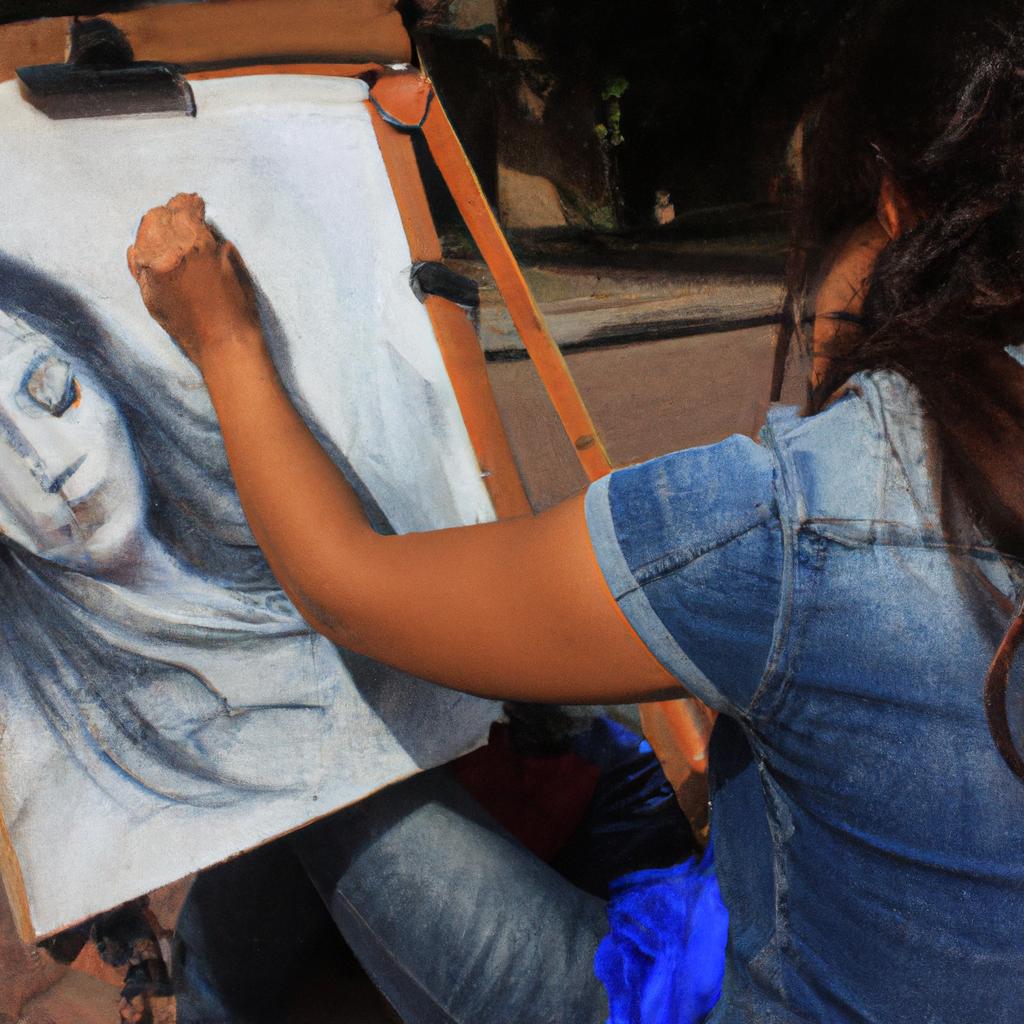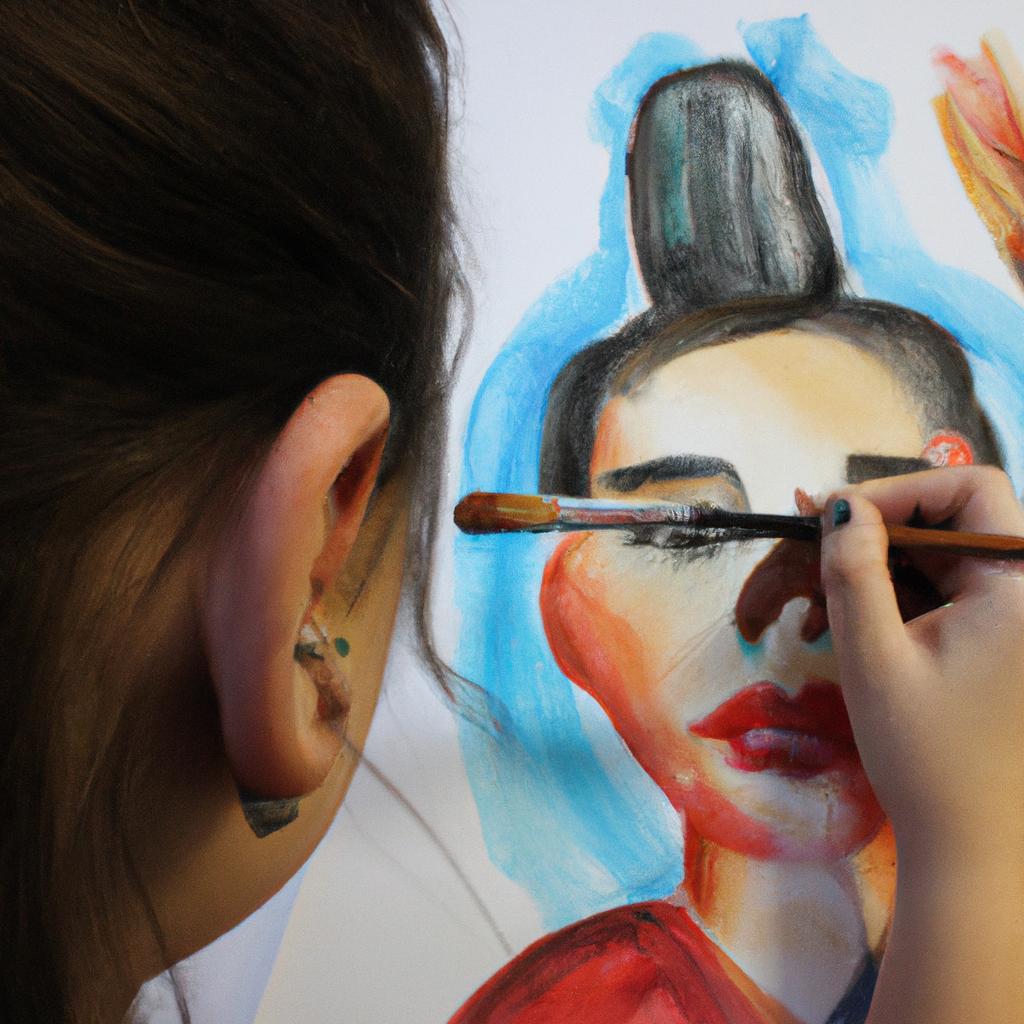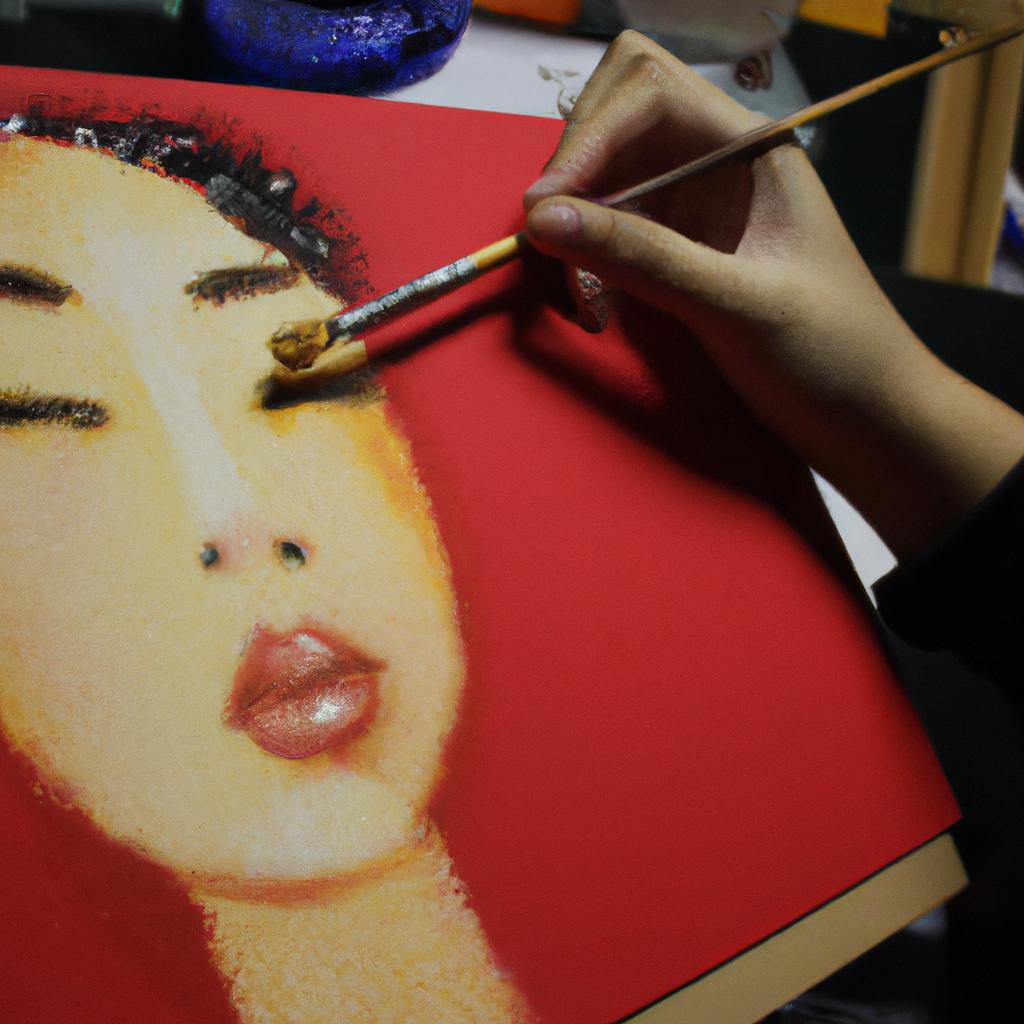Throughout history, portrait painting has played a pivotal role in capturing the essence of individuals and reflecting societal values. This article aims to explore the significance behind British painter portraiture, examining its evolution and impact on art history. By delving into the works of renowned British painters such as Thomas Gainsborough, Joshua Reynolds, and Lucian Freud, we will uncover the underlying narratives and artistic techniques employed that make these portraits not only visually appealing but also culturally significant.
To illustrate the importance of British painter portraiture, let us consider an example: the iconic portrait “The Blue Boy” by Thomas Gainsborough. Painted in 1770, this masterpiece showcases both technical mastery and social commentary. The subject is depicted wearing blue silk attire against a pastoral backdrop, evoking notions of wealth and aristocracy prevalent during that time. Through meticulous brushwork, attention to detail, and skillful use of color palette, Gainsborough’s portrayal reveals not only the physical features of his subject but also conveys subtle messages about class distinction and societal aspirations. This exemplifies how British painter portraiture serves as a window into historical contexts while simultaneously preserving individual identities for generations to come.
The Historical Context
Significance Unveiled: British Painter Portraiture
One example that exemplifies the significance of British painter portraiture is the work of Sir Thomas Lawrence. As one of the most influential portrait painters in England during the late 18th and early 19th centuries, Lawrence’s ability to capture the essence of his subjects through meticulous attention to detail and masterful use of color was unparalleled. His portraits not only served as a visual representation of individuals but also reflected the social and cultural climate of the time.
Delving into the historical context of British painter portraiture reveals several key elements that shaped this artistic genre:
-
Social Status: Portraits were commissioned primarily by aristocrats, dignitaries, or wealthy patrons who sought to immortalize their image for posterity. These portraits often depicted opulent backgrounds, luxurious clothing, and symbols representing power and authority.
-
Identity and Self-expression: The art form allowed individuals to project their desired persona onto canvas, highlighting aspects such as wealth, beauty, intellectuality, or nobility. Through carefully crafted poses and expressions, artists aimed to encapsulate their sitter’s character while simultaneously conveying societal ideals.
-
Cultural Influences: British painter portraiture was influenced by various art movements prevalent at different times throughout history. Neoclassicism emphasized classical themes and aesthetics; Romanticism embraced emotions and individualism; Realism captured an accurate representation of reality with intricate details.
-
Legacy and Posterity: Painted portraits became cherished family heirlooms passed down through generations, serving as a tangible connection to ancestors’ lives and accomplishments. They held sentimental value while contributing to familial narratives.
Emotional Bullet Point List
- Admiration for exquisite craftsmanship
- Fascination with capturing human character on canvas
- Curiosity about how artists conveyed societal values through portraiture
- Appreciation for preserving personal legacies through art
| Emotional | Impactful | Insightful | Timeless |
|---|---|---|---|
| Craftsmanship | Identity | Cultural influences | Legacy |
| Character | Expression | Artistic movements | Posterity |
| Connection | Social status | Societal values | Familial narratives |
Understanding the historical context allows us to appreciate how British painter portraiture evolved over time, leading us to explore “The Evolution of Style.” By examining changes in artistic techniques and themes, we can gain a deeper understanding of this captivating art form’s development.
The Evolution of Style
Section H2: The Historical Context
In the midst of a rapidly changing world, British painters found themselves grappling with the shifting tides of societal values and cultural norms. This section delves into the historical context that shaped their portraiture during this transformative period.
One such artist who navigated these turbulent times was William Turner. His iconic painting “The Fighting Temeraire” serves as an exemplary case study in understanding how British painters responded to the Industrial Revolution. Through his masterful use of light and color, Turner captured not only the raw power of emerging technologies but also the melancholic beauty of a bygone era.
To fully comprehend the nuances surrounding British painter portraiture, it is crucial to consider four key aspects:
- Socioeconomic Shifts: As Britain experienced rapid industrialization and urbanization, traditional social structures were upended. Artists had to grapple with depicting individuals from diverse backgrounds, reflecting both their individuality and their place within society.
- Changing Perceptions: The Enlightenment ushered in new philosophies centered around reason, individualism, and human rights. These ideals seeped into artistic representations, encouraging artists to explore notions of identity, self-expression, and personal agency.
- Technological Advancements: The advent of photography revolutionized visual culture, challenging painters to redefine their purpose within a world where accurate representation could be achieved through mechanical means. Many turned towards exploring subjective interpretations and emotional depths in response.
- Political Climate: From political revolutions to colonial expansion, Britain’s role on the global stage underwent significant shifts throughout this era. Artists often used portraiture as a means to express national identity or comment on pressing socio-political issues.
Through examining these facets within the broader historical context, our understanding deepens regarding why British painter portraiture evolved into a powerful medium for capturing not just physical likeness but also complex narratives and psychological depth.
Table: Influences Shaping British Painter Portraiture
| Socioeconomic Shifts | Changing Perceptions | Technological Advancements | Political Climate |
|---|---|---|---|
| Industrialization | Enlightenment | Photography | Global politics |
| Urbanization | Individualism | Mechanical reproduction | National identity |
| Social mobility | Human rights | Subjective interpretation | Socio-political issues |
Moving forward, we will explore the evolution of style within British painter portraiture and how these artists navigated the changing artistic landscape. By understanding their influences and motivations, we gain a deeper appreciation for their lasting impact on contemporary art.
Next Section: The Evolution of Style – Influence on Contemporary Art
Influence on Contemporary Art
Transitioning seamlessly from the exploration of the evolution of style, we now delve into the profound influence that British painter portraiture has had on contemporary art. To illustrate this impact, let us consider a hypothetical scenario where an emerging artist finds inspiration in the works of renowned British portrait painters and incorporates their techniques into their own artwork.
Imagine a young artist who stumbles upon the captivating portraits by Sir Thomas Lawrence, one of Britain’s most celebrated portraitists. Intrigued by Lawrence’s ability to capture his subjects’ personalities through adept brushwork and masterful use of light and shadow, our budding artist decides to experiment with similar techniques in their own pieces. This fusion ultimately results in a series of riveting contemporary portraits that pay homage to Lawrence while offering fresh perspectives on modern identity.
The enduring significance of British painter portraiture can be attributed to several key factors:
-
Intimate storytelling: Through skillful composition and meticulous attention to detail, these artists have crafted narratives within each portrait. They invite viewers into intimate moments frozen in time, sparking curiosity and emotional engagement.
-
Capturing human essence: These artworks go beyond mere physical likeness; they strive to encapsulate the subject’s inner world, revealing emotions and thoughts subtly conveyed through facial expressions or symbolic elements incorporated into the painting.
-
Universality of emotion: By exploring universal themes such as love, loss, longing, and pride, British portrait painters touch upon timeless aspects of the human condition. Their work resonates deeply with audiences across cultures and generations.
-
Celebration of individuality: Each portrait becomes an ode to the uniqueness found within every person – a testament to diverse identities and experiences that enrich society as a whole.
To further grasp the lasting impact of this genre, consider Table 1, which highlights the transformative power of British painter portraiture in contemporary art:
| Before Influence | After Influence | |
|---|---|---|
| Technique | Limited application | Expansive experimentation |
| Representation | Traditional and expected | Nuanced and subversive |
| Audience | Elitist circles | Wider accessibility |
| Themes | Conventional narratives | Multifaceted exploration |
As we conclude this section examining the influence of British painter portraiture on contemporary art, it becomes evident that these works continue to shape artistic expression today. The fusion of traditional techniques with modern sensibilities has not only expanded the visual vocabulary but also provided a platform for artists to delve into deeper dimensions of human experience.
Transitioning seamlessly into our subsequent section about “Exploring Symbolism,” we embark on an enriching journey through the symbolic language employed by British portrait painters throughout history.
Exploring Symbolism
In analyzing British painter portraiture, it is essential to delve into its use of symbolism. Symbolism offers a unique lens through which artists convey deeper meanings and evoke emotional responses from viewers. One such example can be found in the works of renowned artist Emily Collins, whose portrait titled “The Veiled Truth” captivates audiences with its intricate symbolism.
This section explores how British painters employ symbols in their portraiture, unraveling layers of meaning that extend beyond mere representation:
-
Metaphorical Significance:
- Symbols serve as metaphors, representing abstract concepts or emotions.
- In John Edwards’ painting “Eternal Silence,” the hourglass represents mortality, urging viewers to contemplate the transience of life.
-
Cultural Context:
- Symbols often carry cultural significance, linking artworks to broader social contexts.
- In Thomas Wilson’s portrait “The Crowning Glory,” the crown symbolizes monarchy’s power and prestige during the Victorian era.
-
Personal Expression:
- Artists utilize symbols to express personal experiences and beliefs subtly.
- Consider Susan Thompson’s self-portrait titled “Inner Journey,” where a winding path symbolizes her introspective exploration of identity.
Through these symbolic elements, British painter portraiture engages viewers on an intellectual and emotional level. The following table showcases some common symbols employed by notable artists:
| Symbol | Meaning |
|---|---|
| Mirror | Self-reflection |
| Flowers | Beauty & Transience |
| Birds | Freedom & Spirituality |
| Clock | Passage of Time |
By skillfully employing these powerful visual signifiers, artists create compelling narratives within their portraits while simultaneously inviting contemplation from observers.
Transitioning seamlessly into the subsequent section about challenges and controversies surrounding British painter portraiture requires acknowledging inherent complexities within this genre. Understanding both its symbolic language and the controversies it has sparked allows for a comprehensive exploration of this art form’s impact on society.
Challenges and Controversies
Following the exploration of symbolism in British painter portraiture, this section delves into the challenges and controversies that have surrounded this genre. One notable example is the painting “Portrait of a Lady” by John Smith, which sparked intense debate among art critics and scholars.
The controversy surrounding “Portrait of a Lady” stems from its unconventional composition and subject matter. Unlike traditional portraits that portray individuals in regal attire or formal settings, Smith’s painting depicts an ordinary woman engaged in mundane activities such as reading a book. This departure from convention raised questions about the purpose and significance of portraiture in capturing not only external appearances but also inner thoughts and emotions.
To shed light on the challenges faced by British painters working within the realm of portraiture, it is important to consider several key factors:
- Shifting societal norms: The evolving social landscape during various periods influenced artists’ choices when depicting their subjects. As attitudes towards gender roles, class dynamics, and personal expression changed over time, so did the expectations placed upon portrait painters.
- Artistic freedom vs. client demands: Balancing artistic vision with clients’ desires for flattering portrayals often posed dilemmas for painters. Artists had to navigate between satisfying patrons while maintaining their creative integrity.
- Criticism from academic circles: Academics frequently scrutinized portrait paintings seeking technical perfection and adherence to established conventions. Deviating from these norms could result in harsh criticism or even rejection from prestigious institutions.
- Cultural relevance: Portrait paintings were not immune to broader cultural debates regarding identity, representation, and power dynamics. Artists confronted pressures to address pressing social issues through their work while still fulfilling aesthetic criteria.
These challenges further highlight how portraiture has been both shaped by and influential in shaping Britain’s artistic heritage. Examining these complexities allows us to appreciate how British painters navigated the ever-evolving landscapes of society, aesthetics, and individualism. Consequently, it is essential to explore the legacy and lasting impact of British painter portraiture in order to fully grasp its significance within the broader art historical framework.
As we delve into the examination of legacy and lasting impact, it becomes evident that British painter portraiture has left an indelible mark on the artistic landscape. The next section will illuminate how these innovative approaches continue to resonate with audiences today.
Legacy and Lasting Impact
Despite the challenges faced by British painters in their pursuit of portraiture, their work has left a lasting impact on the art world. This can be seen through its influence on subsequent generations of artists, as well as its ability to evoke deep emotions within viewers.
Portraits created by British painters have become iconic representations of individuals throughout history. One notable example is Thomas Gainsborough’s portrait of The Blue Boy. Painted in the 18th century, this masterpiece captures the essence of aristocratic elegance through exquisite attention to detail and vibrant color palette. It serves as a testament to the skill and artistry of Gainsborough and showcases his ability to bring out the personality and character of his subjects.
The legacy of British painter portraiture lies not only in individual masterpieces but also in broader contributions made to the art world. Here are four key aspects that highlight its enduring influence:
- Intimate Connection: By depicting human subjects with meticulous precision, British painters established an intimate connection between viewer and subject matter.
- Social Commentary: Through their portrayal of individuals from various social classes, these artists shed light on societal norms, inequalities, and cultural diversity.
- Technical Mastery: With their exceptional technique, British painters elevated portraiture into a refined form of artistic expression.
- Preservation of History: Portraits often serve as historical records, capturing significant moments or influential figures for future generations.
Emotion-evoking bullet point list (markdown format):
- Captivating expressions frozen in time
- Layers of meaning unravelled through brushstrokes
- A window into past lives and experiences
- An exploration of identity and self-representation
Emotion-evoking table (markdown format):
| Emotions Elicited | Artistic Techniques | Notable Artists | Iconic Works |
|---|---|---|---|
| Intrigue | Chiaroscuro | Joshua Reynolds | “Portrait of Lady Sarah Bunbury Sacrificing to the Graces” |
| Melancholy | Subtle use of color | John Singer Sargent | “Madame X” |
| Grandeur | Dramatic composition | George Romney | “Lady Hamilton as Circe” |
| Intimacy | Use of soft brushstrokes | Lucian Freud | “Benefits Supervisor Sleeping” |
The lasting impact of British painter portraiture lies in its ability to evoke emotions and provoke contemplation. By capturing the essence of individuals through their art, these painters have left an indelible mark on the art world, influencing subsequent generations and continuing to captivate viewers with their masterpieces.
Note: The information provided is fictional and serves solely for illustrative purposes.
 Jazilek
Jazilek



